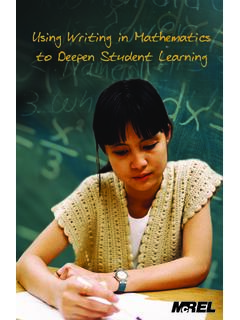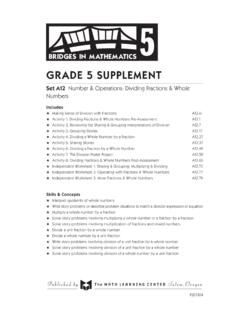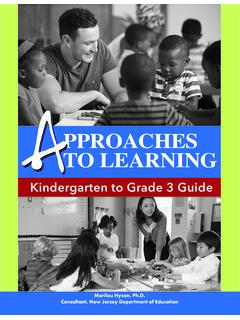Transcription of Supporting Mathematics Discourse with Sentence Starters ...
1 Interactive Technologies in STEM Teaching and Learning RESEARCH + PRACTICE TOOL This document is created by Education Development Center, Inc. Copyright 2017. Funded by a Maine Mathematics and Science Partnership Project (RFP# 201610203). Opinions expressed in this brief are those of the contributors and not necessarily those of the Maine Department of Education. Learn more at Mathematics Discourse with Sentence Starters & Sentence Frames Pam Buffington, Tara Knight, Peter Tierney-Fife 1 Purpose Ms. Knight uses Sentence Starters and Sentence frames with her grade 2 students to support the development of rich Mathematics communication and critique.
2 How do they work? Students are given partial sentences to complete with their own words. For example, students may be given the start of a Sentence to use during a class discussion, such as, I liked when Or, students may have a list of Sentence frames for which they need to fill in the blank(s) with numbers or words while they explain their problem solving process. Background To support the development of rich student math talk in the classroom, students need help learning and using academic language structures, practicing communication and critique, and building understanding of academic vocabulary through use in context (Scarcella, 1996; Schleppegrell, 2002).
3 Their experiences should help them bridge from the informal speech that they bring to the classroom to a rich Discourse that incorporates the academic language of Mathematics . Students must do more than just use Mathematics vocabulary, since vocabulary can often be used without understanding. Students must engage in Discourse that is connected to their thinking about the math with which they are engaged and that supports deeper understanding. The language relative to academic content is quite different from everyday conversations. Academic language refers to the specialized vocabulary, grammar, Discourse /textual, and functional skills associated with academic instruction and mastery of academic material and tasks.
4 (Saunders, Goldenberg, and Marcelletti, 2013) The use of Sentence Starters and frames help students develop academic language by providing grammar and syntax structures for mathematical Discourse that students can use and learn. Teachers need to make academic language expectations explicit (Fillmore and Snow, 2000) and one efficient way to get students to apply academic language is to RESEARCH + PRACTICE TOOL 2 2provide opportunities for prepared participation, which affords them time to collect their thoughts (Feldman and Kinsella, 2005). Sentence Starters and frames help provide these opportunities and can be used to support student explanation, develop skills for peer critique, scaffold group or class dialogue, and be used to engage with Mathematics vocabulary and math-specific word meanings in context.
5 They can also be used more broadly for student reflection and in other content areas. Ms. Knight used a variety of Sentence Starters and frames with her students, starting with Sentence frames that support student explanations of a procedure or their problem solving process. Sentence Starters such as, The first thing I did to solve the problem can help students including students who normally speak little or not at all in math class talk more about their work. Although many Sentence frames Ms. Knight used with students were applicable to a wide variety of problems and lessons, some were tailored for specific tasks or strategies.
6 A few examples are given in the box in the upper right of this page. Sentence Starters and frames can also provide structure to elicit and deepen student understanding. For example, the Sentence Starters , I discovered and, I knew my answer was reasonable because .. prompt students to think deeply about specific aspects of their problem solving process while providing a structure for talking about it. Examples of Sentence Starters that Ms. Knight used with her students to elicit and deepen their thinking are in the second box on the right. In addition to Sentence Starters and frames that support students in sharing and thinking deeply about their own work, different types of Sentence Starters and frames can support peer discussion and peer critique of Mathematics problem - solving .
7 For example, Sentence Starters such as, Can you explain how and, I wonder why help students engage with their peers and extend their Mathematics dialogue. When students use Sentence Starters and frames such as, Can you tell me how you and, What does the _____ in your drawing represent? , they are reinforcing the importance of clear explanations and the use of visual representations for themselves and their peers. Ms. Knight supported peer critique by using Sentence Starters and frames like the examples in the third box from the top. In addition, she used questions similar to those in the bottom box to probe student thinking and support peer critique in classroom discussions and group work.
8 3 Sentence Starters and Frames To Develop Language Structure Generic sent ence start ers You can see my strategy on this [number line/ten frame]. I started First, Next, Finally, Sentence frames for a specific task using a counting up through 10 strategy for subtraction I started at _____ and counted up to 10. That was _____ jumps of _____. Then I counted to _____. That was _____ jump of _____. Then I added my jumps to get _____. So, _____ _____= _____. Sentence Starters and Frames To Elicit & Deepen Student Thinking I know the answer is reasonable/correct The first thing I did to solve the problem I can check my answer I proved my thinking The strategy I used I discovered I noticed I Sentence Starters and Frames for Peer Critique I agree/disagree with you Can you tell me how you Can you explain how/why What you did is similar Did you think I hear you say I wonder how/why I liked when you.
9 Sentence Frames for Educators to Support Student Critique Do you agree or disagree with _____ and why? How is that different from what _____ did? How is that the same as what _____ did? Explain what _____ just said. Why do you think _____? RESEARCH + PRACTICE TOOL 3 4 Resources Interactive Stem: Supporting Mathematical Discourse in the Early Grades Education Development Center, 2015 Math Talk Sentence Starters Wilford, K., 2016 MathSolutions Video: Math Talk in Action - 1st Grader 2016 Scholastic, Inc. Source: Anderson, , Chapin, S. H., & O Connor, C.
10 , 2011 Classroom Discussions in Math: A Facilitator s Guide to Support Professional Learning of Discourse and the Common Core, Grades K 6: A Multimedia Professional Learning Resource Inside Mathematics V ideo: Number Talk: 1st Grade Math - Quick Look With Ten Frames 1997 2016, the Charles A. Dana Center at The University of Texas at Austin; featuring O Neill, L. References Feldman, K., & Kinsella, K. (2005). Narrowing the language gap: The case for explicit vocabulary instruction. New York: Scholastic. Retrieved from Fillmore, , & Snow, C. (2000). What teachers need to know about language.








